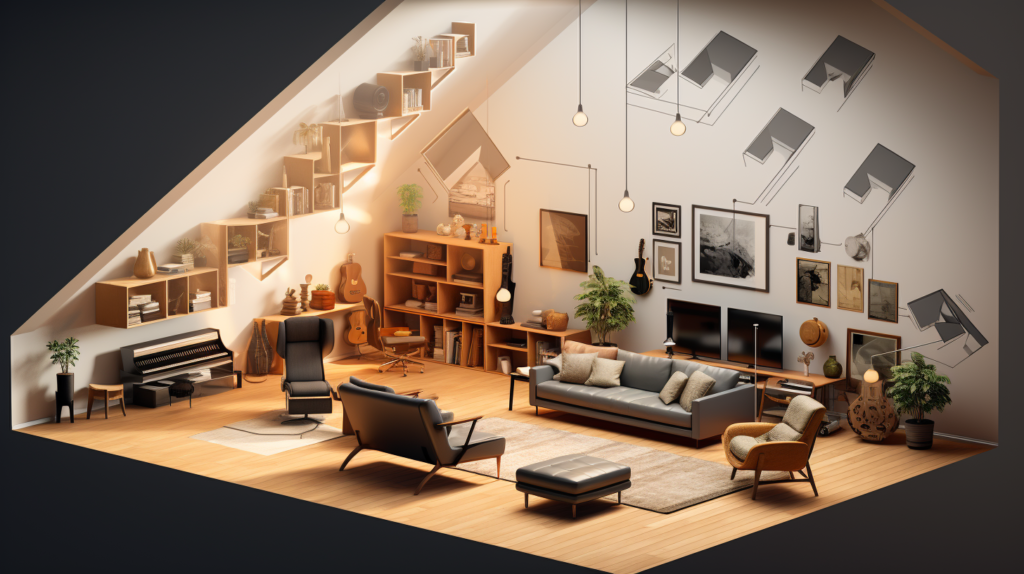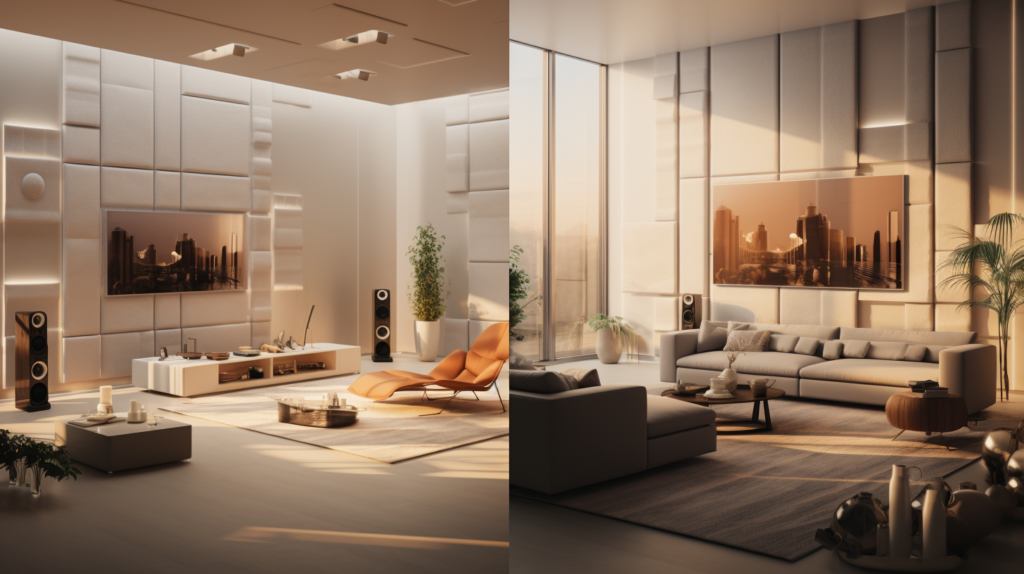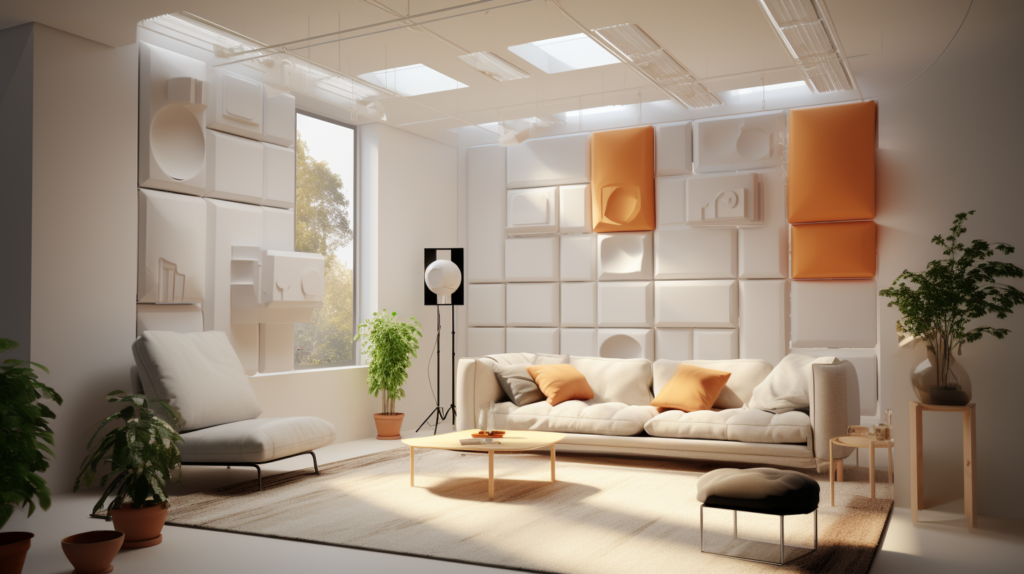Home theater sounds boomy. Recording vocals have distracting echoes. Your open office rumbles with chatter. If this sounds familiar, your room needs acoustic treatment.
But adding random acoustic panels falls short of truly optimizing your space. You need to carefully calculate and place the right amount.
In this comprehensive guide, we’ll cover how to determine the ideal acoustic panel quantity for any room.
Follow along as we demystify acoustic math and placement strategies. With the right know-how, you’ll create an oasis of sound tailored to your space.
Let’s dive in…
How Many Acoustic Panels Do I need Exactly?

The ideal number of acoustic panels needed depends on several factors like room size, intended use, issues to address, and budget.
As a general guideline:
Small rooms need about 10 panels
Medium rooms need around 20 panels
Large rooms require approximately 30 panels.
Recording studios need 40.
More specialized spaces like home theaters need 60 panels
Carefully position panels using proven techniques like the 1/3 Rule for optimal acoustic treatment.
Overall, it’s crucial to calculate and place the right acoustic panel quantity for your particular room.
Do I Need Acoustic Panels?

Adding acoustic treatment can seem daunting at first. How do you know if your room would actually benefit from acoustic panels?
Read more to understand what are acoustic panels
There are some clear signs that indicate your room needs acoustic treatment. One sign is if you hear a rapid fluttering sound after making a loud noise like clapping.
This flutter echo is caused by sound bouncing between parallel hard surfaces. Another indicator is boomy and bloated sounding speakers or voice, often from excessive reverberation amplifying lower frequencies.
If details become lost and muddy in the room’s excessive liveliness, with imaging and stereo separation also suffering, this points to the need for treatment.
Annoying echoes, slapback, or metallic ringing from reflective floors, walls, and ceilings are also distracting reflections that acoustic panels can address.
Furthermore, HVAC rumble, street noise, creaks, and chair scrapes are all exaggerated by a live space, contributing to excess background noise issues.
Conversations that are difficult to understand clearly amidst the room’s excessive reverb and ambient noise demonstrate intelligibility problems that treatment can improve.
If you notice any of these issues, your space will likely benefit from acoustic treatment.
Strategically placed panels absorb sound reflections and reverberation to create a cleaner, more balanced sound.
Just be sure not to over-treat the room. It takes some panels in the right spots to make a dramatic difference.
Understand more about art acoustic panels that can help make the aesthetics great while helping you to reduce the noise in a space.
If you are worried about getting such many acoustic panels, here are some guides to let you understand if acoustic panels really works:
Will Acoustic Panels Help With Noisy Neighbors?
Do Acoustic Panels Block Sound And Keep Sound Out? (Despite What Everyone Is Saying…)
Do Wooden Acoustic Panels Work?
Do Acoustic Panels Work In Apartments? What Could They Help With?
Do Acoustic Panels Work Both Ways? How Do Acoustic Panels Work Both Ways?
How to Determine the Ideal Number of Acoustic Panels for Your Room

Adding acoustic panels is one of the most effective ways to treat room acoustics and achieve your ideal listening environment.
But how many panels do you actually need? Getting the right amount is crucial for optimal sound quality without over-treating.
In this comprehensive guide, we’ll cover how to calculate the ideal acoustic panel quantity for rooms of all sizes and uses.
Follow along to understand the methodology and easily determine how many you need for your specific space.
What Are Factors That Affect the Number of Acoustic Panels Needed

While we’ve provided general panel amount recommendations, the ideal number for your space depends on several factors:
Room Size and Shape – Larger and more complex rooms need more panels. Tall ceilings also increase treatment needs. Compute total wall/ceiling area when calculating panel requirements.
Room Use – Spaces for sound critical activities like theaters and studios need more treatment than casual spaces. Office conference rooms need more focus than open work areas.
Room Problems – If treating significant flutter echo, bass resonances, or ambient noise, additional panels may be required beyond the basics.
More on installation for different room types:
Should You Put Acoustic Panels Behind Speakers? Your Questions Answered
Where To Place Acoustic Panels? A Comprehensive Guide For Improved Sound
Where to Place Acoustic Panels in a Home Theater? (Complete Guide For Optimal Sound)
How to Acoustically Treat a Large Hall for Clear Sound
The Complete Guide to Acoustic Treatment: Acoustic Panels, Bass Traps, and Room Acoustics
Panel Types – Thicker, density packed panels with rigid fiberglass or rockwool absorb lower frequencies more effectively per panel. Thin foam only absorbs high frequencies and needs greater coverage.
Check out our top 10 best acoustic panels recommendation for you.
Aesthetic Preferences – Full wall/ceiling coverage provides maximum acoustic treatment, but lower percentages around 30-40% balance acoustics with aesthetics.
Budget – The number of panels comes down to budget too. Prioritize first reflection points and bass trapping when limited. It’s easy to always add more.
Consider all these factors together when choosing the right acoustic panel amount for your specific room’s needs and constraints. An experienced acoustical consultant can provide more detailed guidance if needed.
How Many Acoustic Panels Do I Need? What Are The Exact Numbers?

When designing your ideal acoustic environment, determining the right number of panels is the crucial first step.
Our in-depth analysis explored the ideal quantity of acoustic panels required for spaces of varying sizes and uses.
We found that small rooms need 10 panels, medium rooms need 20 panels, and large rooms need 30 panels.
Specialized rooms like theaters need 60 panels and studios need 40 panels. Offices require around 60 panels and restaurants need about 24 panels.
We calculated the recommended amounts using a proven technique called the 1/3 Method. Which we also advised as a rule of thumb.
This factors in the room’s dimensions, intended usage, and other parameters to precisely gauge treatment needs.
However, how many panels you need will depend on the actual situation you are in.
If you are unclear, use the following as a guide and search for an acoustic panel calculator online to have them help you calculate the number of acoustic panels you need.
But reference back to this article for a sanity check.
How Many Acoustic Panels Do I Need In My Room?
For a small room, our analysis indicates approximately 10 acoustic panels are ideal. We based this on average small room dimensions of 12 square footage (3.6m x 3.6m) with 8-foot high ceilings measuring the room. For typical casual use, 30% coverage of the hard surfaces is recommended.
How Many Acoustic Panels Do I Need In A Medium-Sized Room?
A medium-sized room requires about 20 panels. This room size has average dimensions of 14 x 18 feet (4.2m x 5.4m) with a 9-foot ceiling.
The moderate size still only needs 30% hard surface coverage for most general purposes.
How Many Acoustic Panels Do I Need In A Large Room?
When moving into larger spaces, the panel quantity must increase to maintain adequate acoustic control.
For a big room measuring 18 x 24 feet (5.4m x 7.2m) with 12-foot ceilings, our recommendation is 30 panels.
How Many Acoustic Panels Do I Need In My Home Theater?
The room’s intended use also factors in. For home theaters, around 60 panels help optimize audio clarity and envelopment based on their immersive sound requirements.
How Many Acoustic Panels Do I Need In My Studio?
Recording studios demand about 40 panels for clean, balanced sound.
How Many Acoustic Panels Do I Need In My Office & Restaurants?
For office spaces, approximately 60 panels are ideal based on typical large open floorplans. Restaurants need around 24 panels to control noise and enhance speech intelligibility.
Where Is The Best Place To Put Acoustic Panels?

When it comes to achieving optimal sound quality and reducing unwanted echoes, reverberations, and background noise, acoustic panels play a crucial role.
However, knowing exactly where to place these panels in different rooms can sometimes be a challenging task.
Here are some recommendations for where to place your panels in each space:
Where Is The Best Place To Put Acoustic Panels In A Small Room?
For a small room measuring 10 ft x 10 ft, here are some recommendations for placing acoustic panels:
– To achieve balanced acoustics, distribute the 10 acoustic panels evenly across the four walls.
– Consider placing two panels on each wall. It is beneficial to position one of the panels at the center height of the wall to intercept sound reflections in the middle of the room.
– Additionally, you may want to consider placing a few acoustic panels on the ceiling. These can be positioned in the center or evenly spaced to help absorb sound and improve the overall acoustic quality of the room.
Where Is The Best Place To Put Acoustic Panels In A Medium Room?
In a medium-sized room measuring 12 ft x 12 ft, here’s how you can optimize the placement of acoustic panels:
– To ensure even sound distribution and balance, distribute the 10 acoustic panels evenly across the four walls.
– Aim to place two to three panels on each wall. It is recommended to include at least one panel at the center height of the wall to effectively absorb sound reflections.
– Consider augmenting the acoustic treatment by adding a few panels on the ceiling. Placing them in the center or evenly spaced can help with sound absorption and enhance the overall acoustics of the room.
Where Is The Best Place To Put Acoustic Panels In A Large Room?
For a large room measuring 14 ft x 16 ft, here are some suggestions for placing acoustic panels:
– To achieve optimum sound distribution and balance, distribute the 14 acoustic panels evenly across the four walls.
– Aim to place three to four panels on each wall. Be sure to include panels at the center height of the walls to effectively intercept sound reflections and maintain balanced acoustics throughout the room.
– Considering the ceiling, it is recommended to place a few panels in the center or evenly spaced to further enhance sound absorption and improve the overall acoustic quality of the space.
How About My Home Theater?
If you have a home theater with dimensions of 20 ft x 15 ft, here’s how you can strategically position acoustic panels:
– To create an immersive audio experience, distribute the 27 acoustic panels evenly across the four walls. Aim to place six to seven panels on each wall, ensuring comprehensive coverage.
It is crucial to include panels at the center height of the walls to optimize sound distribution and achieve a balanced soundstage within the room.
– For the ceiling, consider placing panels in a grid pattern or evenly spaced to further enhance sound absorption.
– Don’t forget to also place panels on the rear wall, distributing them evenly, including at the center height, to effectively control sound reflections.
How About My Home Studio?
In a home recording studio measuring 10 ft x 13 ft, here are some recommendations for acoustic panel placement:
– To optimize the acoustics of your recording studio, distribute the 14 acoustic panels evenly across the four walls.
– Aim to place two to three panels on each wall, ensuring comprehensive sound absorption. Including one or two panels at the center height of the walls can effectively intercept sound reflections and improve the overall acoustic environment.
– Consider adding a few panels on the ceiling, positioning them in the center or evenly spaced, to further enhance sound absorption and create a more controlled recording space.
Where Is The Best Place To Put Acoustic Panels In My Living Room?
For a living room measuring 16 ft x 20 ft, here’s how you can strategically position acoustic panels:
– To achieve a balanced acoustic environment, distribute the 15 acoustic panels evenly across the four walls.
– Aim to place three to four panels on each wall, ensuring comprehensive coverage. It is recommended to include panels at the center height of the walls to effectively intercept sound reflections and promote balanced acoustics within the room.
– For the ceiling, consider placing a few panels in the center or evenly spaced to enhance sound absorption and improve the overall acoustic quality of the living room.
Where Is The Best Place To Put Acoustic Panels In Office?
In an office space measuring 98 ft x 98 ft, here are some recommendations for placing acoustic panels:
– To optimize the acoustics of your office, distribute the 60 acoustic panels evenly across the four walls.
– Aim to place 15 panels on each wall, ensuring comprehensive sound absorption throughout the space.
Including panels at the center height of the walls will help optimize sound distribution and balance.
– Considering the ceiling, you may want to place panels in a grid pattern or evenly spaced to further enhance sound absorption and create a more favorable acoustic environment for workspaces.
Open Office Spaces
In open office spaces, where collaboration and communication are key, strategic placement of acoustic panels can help create a more productive and comfortable environment.
Here are some recommendations:
– Walls: Distribute a total of 60 acoustic panels evenly across the walls of the open office space. Aim to place approximately 15 panels on each wall to ensure comprehensive coverage.
– Position the panels strategically where sound reflections are likely to occur, such as near workstations, meeting areas, and high-traffic zones. Including panels at the center height of the walls can help optimize sound distribution and balance.
– Ceiling: Consider placing acoustic panels in a grid pattern or evenly spaced across the ceiling. The number of panels will depend on the specific dimensions of the office space, but aim to achieve a balanced distribution for effective sound absorption.
This can help minimize noise propagation and create a more acoustically controlled open office environment.
Conference Rooms
In conference rooms, where effective communication and clear audio are crucial, proper acoustic treatment is essential.
Here’s how you can optimize the placement of acoustic panels:
– Walls: Distribute the acoustic panels evenly across the walls of the conference room. The number of panels will depend on the size of the room but aim to place panels strategically to minimize sound reflections and improve speech intelligibility.
Positioning panels at the center height of the walls can help absorb reflections and create a more focused acoustic environment during meetings and presentations.
– Ceiling: Consider placing acoustic panels in a grid pattern or evenly spaced on the ceiling. The number of panels will depend on the dimensions of the conference room but aim for a balanced distribution to enhance sound absorption. This can help reduce reverberation and improve overall sound clarity in the conference room.
– Additional Considerations: Depending on the specific layout and acoustics of the conference room, you may also want to consider placing panels on doors, windows, or other surfaces that could potentially contribute to sound reflections.
The number of panels required for these additional surfaces will depend on their size and placement within the room.
Where Is The Best Place To Put Acoustic Panels In Restaurants?
For a restaurant with dimensions of 36 ft x 36 ft, here’s how you can strategically position acoustic panels:
– To create a pleasant dining atmosphere, distribute the 24 acoustic panels evenly across the four walls
– Aim to place six panels on each wall, ensuring comprehensive coverage.
– Including panels at the center height of the walls can effectively manage sound reflections and improve the overall acoustic quality of the restaurant.
Conclusion
Determining the right number of acoustic panels is key to optimizing any space for sound. Follow our recommendations to treat small, medium, and large rooms plus specialized spaces like studios, theaters, offices, and more.
Remember to consider the full range of factors like room specifics, intended use, problems to address, and budget.
Thoughtfully placing panels using our placement tips will enhance absorption and reduce reflections.
With this comprehensive guide, you now have the methodology to confidently calculate and position the ideal acoustic panel quantity for your particular room.
Turn your space into an acoustic oasis, whether for critical audio work or casual enjoyment.
If challenges persist even after careful treatment, enlist an experienced acoustical consultant. They can provide more robust analysis and custom solutions.
Equipped with the right know-how, you can achieve your desired balance of aesthetics and acoustics. Enjoy the process of dialing in the perfect listening environment. The difference proper acoustic treatment makes is incredibly rewarding.
Frequently Asked Questions

Should There Be Space Between Acoustic Panels?
It’s generally recommended to leave a small gap between acoustic panels to prevent unwanted acoustic effects from flush mounting. A gap of 2-4 inches allows the panels to function most effectively.
How Far Apart Should Acoustic Panels Be?
As a general rule, acoustic panels should be spaced 2-4 feet apart for optimal sound absorption. The exact spacing will depend on the size of the panels and the acoustics of the specific room.
Closer placement risks losing effectiveness.**Can I have too many acoustic panels?**
It is possible to over-treat a room with too many acoustic panels, deadening the sound too much.
As a guideline, cover 30-40% of the total wall and ceiling area in most rooms. Recording studios may approach 60% coverage.
How Big Should My Acoustic Panels Be?
Acoustic panels are commonly 2×4 feet or 4×2 feet. Large wall panels around these sizes help control low-mid frequencies.
Smaller 12×12-inch panels can treat high frequencies. Mix panel sizes as needed for your room.
Can You Have Too Many Acoustic Panels?
The number of acoustic panels you need depends on your goals. If you’re aiming for noise reduction, it’s hard to have too many panels.
However, for spaces where sound quality matters—like recording studios or home theaters—over-treating the room can make it sound “dead.”
In these cases, it’s best to balance acoustic panels with diffusers to achieve both noise reduction and good sound quality.
How Often Do You Have To Replace Acoustic Panels
Acoustic panels have varying lifespans depending on several factors such as material and environmental conditions. On average, most acoustic panels can last anywhere from 5 to 10 years with proper care.
However, if you opt for polyester acoustic panels, you’re looking at an even longer lifespan. These panels are known for their durability and can last up to 30 years, making them an excellent long-term investment for any space requiring acoustic treatment.
